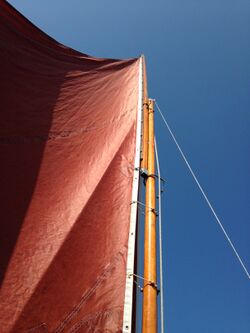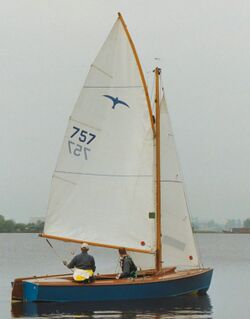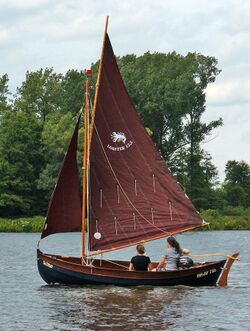Gunter
Topic: Engineering
 From HandWiki - Reading time: 5 min
From HandWiki - Reading time: 5 min
In sailing, a gunter is used for two main configurations of rig:
- The gunter is defined as a wire that leads from one point near the end of a gaff to a point near the other end. A block travels along this wire, and a halyard is attached to this block. This allows the gaff to be raised to the vertical by a single halyard, though another halyard is required at the gaff jaws to control height.
- The gunter is created by hoops or parrel beads which secure the gaff loosely to the mast in a vertical position. A halyard is bent to the gaff jaws to control height.
A sail raised by either of these means is called a gunter rigged sail. A vessel with a gunter rigged mainsail is called a gunter rig.
Gunter rig is normally used on small gaff rigged sailing vessels, such as sailing canoes (not the International Canoe) and dinghies where the gaff is carried very nearly vertical, forming an extension to the mast so that the sail is triangular, resembling a Bermuda rig. The effect is to have a topmast (the gaff) which is a pseudo telescopic extension of the shorter mast. One reason given for the popularity of the gunter rig in dinghies, notably the Mirror dinghy, is that the mast and yard are sufficiently short to pack neatly inside the hull when a boat is being trailed behind a car.
Operation
In what follows, broadly speaking, the 'single halyard' sail is known as a "sliding gunter," while the 'double halyard' sail is a "folding gunter." The sliding gunter yard stays essentially vertical while being raised, while the folding gunter is 'hinged' up to the mast from the horizontal, much like a high-peaked gaff sail.
It should also be noted that while the term yard is normally employed to name a spar which crosses a mast, and gaff one which is fastened to the mast at its forward point — as it is in the case of the gunter rig. However, since the gunter rig is derived from lug rigs - where the spar from which the sail hangs is always called the yard, rather than from gaff rig - despite the similarity between a high peaked gaff rig and a gunter rig, the spar will often be referred to either as a gaff or a yard.

Single halyard
- fix the gaff loosely to the mast in a vertical position, parallel to it, with either hoops or parrel beads so that it will slide freely to the desired height, and ensure that the sail is bent to the gaff.
- secure jaws of the gaff around the mast with parrel beads if the gaff is a jawed gaff, or rely on the hoop if hoops are employed.
- bend the throat halyard to the jaws
- haul the jaws up the mast until the desired height is reached and make fast
- using whatever reefing mechanism you have, usually reefing points, reef any excess sail at the foot to the boom (if any) or gather the belly of the sail if loose footed.
Even with a single halyard the hooped gunter is a vertical sliding gaff
Double halyard
One halyard, the peak halyard, has a block, sometimes just a shackle, that allows the gunter (wire parallel to the gaff and fixed to it at two points on its upper (or leading) surface) to raise the gaff into the vertical position up against and parallel to the mast. The other, the throat halyard, is used to raise or lower the jaws of the gaff.
The mode of operation is:
- bend the peak halyard to the sliding device on the gunter
- bend the throat halyard to the jaws
- secure the parrel beads around the mast from jaw to jaw to locate the jaws positively around the mast
- haul the gaff into the vertical with the peak halyard and make fast
- haul the jaws up the mast with the throat halyard until the desired height is reached and make fast
- using whatever reefing mechanism you have, usually reefing points on larger vessels, reef any excess sail at the foot to the boom (if any) or gather the belly of the sail if loose footed.
- adjust the tension in the luff of the sail by adjusting the throat halyard, downhaul, gooseneck or any combination of these.
Reefing
Reefing a gunter rigged boat with a single halyard requires the sail to be fully lowered into the boat and (usually) the halyard repositioned on the yard or (rarely) the sail to be moved downwards along the yard. However some gunter rigged boats, certainly amongst dinghies, have an additional halyard from the end of the yard, to hoist the sail once the yard is hoisted; these are still technically gunter rigged but have borrowed some of the characteristics of the Bermudian rig; essentially the yard is hosted fully and then left in position and regarded as a semi-permanent topmast, with the sail raised up or down it as required.
Confusion between Gaff Rig and Gunter Rig
Over time the two terms have been used with some interchangeability. While a true gaff rig is with the gaff at an angle to the mast, small boats such as the Heron, the Mirror dinghy, both designed by Jack Holt, and other small sailing dinghies have small, light gaffs which are raised to the vertical position by a single halyard fixed close to the midpoint of the gaff.
This looks like a gunter rig when the boat is fully rigged. However it does not have the sliding component of the wire or the hooped gunter.
Nonetheless such small dinghies have been termed 'gunter rigged' and 'gaff rigged' with free use of each term. It is likely that the fluidity of language allows both terms to be used with correctness for these small boats. For larger craft the terms tend to be more rigorously applied.
See also
External links
 KSF
KSF

